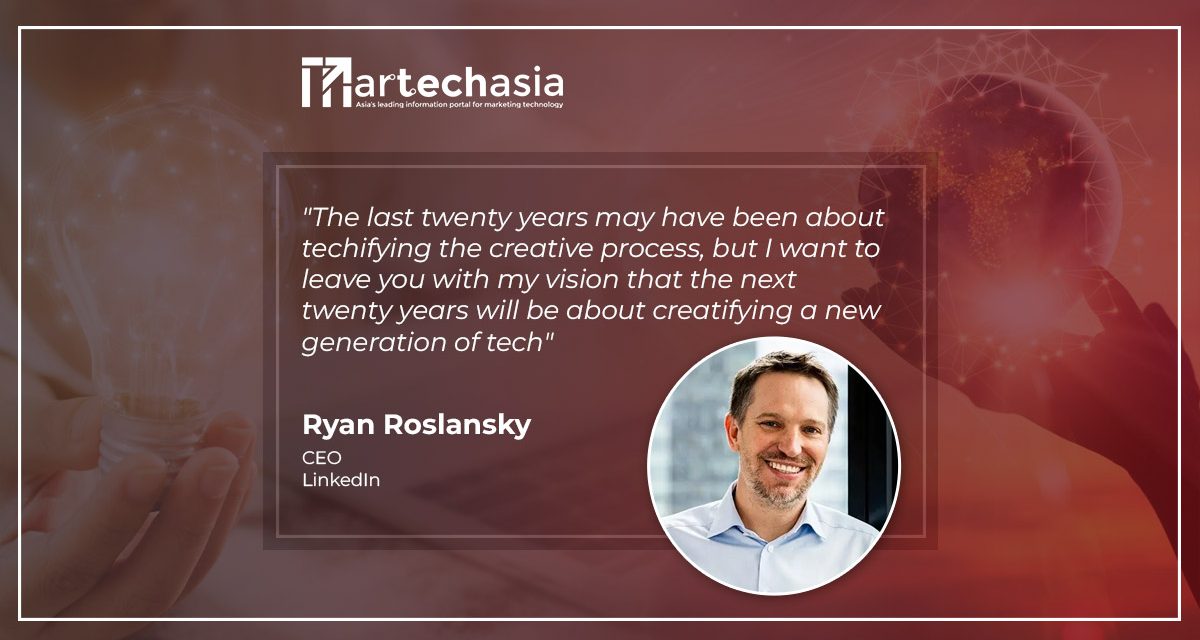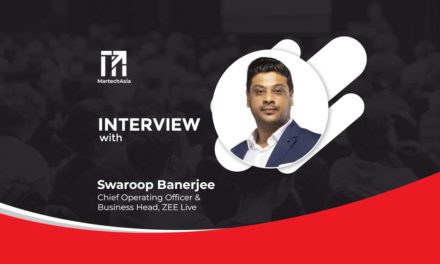The advertising industry is in the promise-making business. People need to understand what it promises before they can decide to want it.
Imagine that I could show you a dozen new brands that will go on to be as big as Nike, Coca Cola, Adidas or Ford? Imagine that I could show you ten companies that you’ve never heard of who, with the help of the advertising industry, will change the economic future of the world?
What if I could show you a path to growth where this industry builds on its incredible creative legacy, instead of feeling that it is losing the battle for talent and unsure of what the future will bring?
I’ve been asked to talk about what is happening with talent in the advertising industry because many sense that something is not right. Those in the industry are worried about how to attract talent, how to deal with pressure on margins, and how you are going to compete in the future.
Many of you know LinkedIn as that blue app on your phone, but beneath that blue app is an active network that gives us access to trends and insights across the global labor market. We call this the Economic Graph. It’s comprised of more than 830 million members, 57 million companies, 14 million jobs, 38,000 standardized skills against those jobs, and 120,000 schools.
And it’s a vibrant graph. It updates roughly 5 million times per minute. It is a real time lens on fundamental shifts occurring across the global labor market.
Through LinkedIn’s Economic Graph, we’re able to see what is really happening in the ad industry by looking at the skills data and talent flows on our platform.
But before going into that, let me tell you a story from a different time.
We are an English coal mining country, and the year is 1773. An ambitious young engineer named James Watt has a BIG problem. James wants the mine owners to use his new steam-powered engine to make the mines safer and more efficient. The steam engine James has invented is amazing – it drains flood water from underground mines faster than the tired and exhausted horses that the miners use. And it is more likely to protect the lives of the people who work underground.
But the mine owners are scared of this new invention. They don’t understand it, they don’t trust it, and they’d rather keep on using horses instead.
So James Watt invents a second amazing thing: the idea of “Horsepower.” Of course steam engines didn’t have horses in them. But, by talking about “Horsepower,” James Watt helps the miners to understand the promise the steam engine really makes.
They can say, “Hey, that thing does the same work as 10 horses? I need it.” Instead of, “Hey, that thing I don’t understand is probably going to blow up and kill my workers. I think I’ll stick with the two horses I’ve got.”
James Watt understood that new technology has to make a promise that is easy to understand before people will buy into it. “Horsepower” was a promise that was so big, and so easy to understand, that it gave birth to the Industrial Revolution and powered a century of change.
If James Watt had tried to sell his technology as the “33,000 Foot Pounds-Of-Force-Per-Minute- Machine” – which was the steam engines’ main product feature – would those mine owners still have taken such a big chance?
The advertising industry is in the promise-making business. Just like James Watt, you know that a great product is not enough. People need to understand what it promises before they can decide to want it.
The MP3 player had been around for a decade before the iPod. It was not new technology. But ‘1000 songs in your pocket’ was the promise everyone understood.
Innovation and promise-making are a powerful combination
One way to look at our economic and social progress over the last 200 years is through the brands that have brought innovation and promise-making together. The history of how we live, work, and consume is in this timeline of brands.
What do these brands have in common? They figured out they had to make great products and great promises. The products may have been complex and novel for their time, but the promises were very easy to grasp. Brand promises have shaped the world for 200 years, and the advertising industry helped build those brands.
The advertising industry today
So, let’s try to understand what is happening in the advertising industry today by looking at what the LinkedIn Economic Graph tells us about talent flows – both across the advertising industry and from a select set of companies who regularly come to the Cannes Lions festival.
830 million professionals have a LinkedIn profile – it’s a digital representation of who they are in the professional world. It’s where they work, what roles they have, and what skills they have. And as mentioned earlier, our graph is updating 5 million times per minute, and it provides tremendous insights.
For example, many in advertising have shared that they are feeling a lot of talent movement in the industry, and that’s right.
We track a metric called job transitions, which is when a member on LinkedIn updates their profile from a job at one company to a job at another. When you look at the year-over-year change in that number, it’s historically been pretty flat in the ad industry. When COVID hit, we saw year-over-year job changes move into negative territory as people sheltered in place to ride out the uncertainty. As COVID started to pull back, job changes moved up again. And in the beginning of 2021, they started to move at record pace.
The picture has settled, but the past 2 years represented an unprecedented amount of talent movement in the ad industry. This is what we refer to as the Great Reshuffle. People are switching jobs at a higher rate than ever before as they figure out not only how and where they work, but why.
What’s fascinating to look at is the fact that the Great Reshuffle has played out differently among generations. Baby Boomers, those born between 1946 and 1964, were the most loyal to their roles well before COVID and straight through the pandemic and recovery. Gen X’ers followed pretty much an identical path until post-COVID, where their tendency to move ticked up a bit. Millennials follow a similar pattern, but when things started to ease in the spring of 2021, they moved at record pace – transitions tipped past the 100% year-over-year mark.
However, this is all in contrast to what we see with Gen Z, who not only were the biggest movers during and post pandemic, but were also the most active movers even before the pandemic struck.
This generation believes it’s ok to move around frequently if they aren’t inspired. Motivating and inspiring this generation is going to be critical to the future of the industry.
Now, let’s look at the mix of skills in the industry and how that is changing. When we look at tech skills and capabilities – hard skills such as data analytics, SQL and Python – over the last 5 years, there has been a big leap. The share of these technical skills in this industry has increased by 47% in the past 5+ years.
When we look at the universe of companies who regularly attend Cannes, we see an even bigger increase in tech skills of 67%. That’s a pretty massive leap over a short time.
But what’s important to understand is that we can see that every industry in the world is ramping up those tech skills too. The arms race for tech talent is global – tech capability has become ‘table stakes’ and every other industry in the world is chasing the same talent.
When we look at the skills at the heart of promise-making such as design, creative strategy, branding and art direction, we don’t see the same scale of growth. In fact, across all talent in the ad industry, the share of creative skills has decreased by 17% over 5 years. And when we look at the Cannes-specific data, we see a 32% decline in the share of creative skills.
Another way of putting that is: in the companies who regularly come to Cannes, there has been a 67% increase in the share of tech skills, and a 32% decline in the share of creative skills over the past 5+ years. Clearly, there has been a big shift in what matters to this industry.
We see an even clearer view of the process of “techification” when we look at overall job hires. In the ad industry in 2015, the ratio of creative roles hired to technical roles hired was 1:1 and in 2021 it was 1:1.25 A net 25% increase in 5+ years. Maybe that doesn’t seem like a big change, but when we magnify this across thousands of roles and companies, we can see that the makeup of the industry is fundamentally changing.
You could argue that this is part of a normal, global-wide shift, but one thing that we should pay attention to is the net talent outflow from this industry. Overall, more people are leaving than joining. Over the last 5 years, advertising has lost 5.5% more people than it has gained. That is significant. By comparison, the tech industry over the same period has gained 23% more people than it has lost.
When I look at these talent flows and skills changes, there’s a very clear picture. This is an industry where the balance is shifting from promise-making and creativity, to digital transformation. That may make sense in a changing world, but I also see an industry that needs to make a much bigger promise to the next generation of talent.
That promise has to be:
“Advertising is where you can have an incredible career.”
“Advertising is where you make promises so big that they change the world.”
“Advertising is where you create huge economic value.”
That’s a promise that will attract every form of talent.
The future of advertising: Putting promise-making at the heart of economic value creation
Again I want to point you to a future you may not have thought of, a future which puts your core competitive advantage–promise-making–right at the heart of economic value creation once again. I want to show you a future that uses your creativity to build the next generation of the biggest brands in the world.
People work in advertising because they want to build iconic brands. But there’s a catch: the biggest brands of today are already big, and already famous. The promises they made are from 20, 30 or even 50 years ago.
To make big, new promises – the kind that careers can be built on, the kind that create economic value and deliver 10X growth not 1% efficiency gains – you will have to discover a new generation of breakthrough products that people don’t know about or understand yet, and use your legendary skill to make them into incredibly famous brands.
Do you think you would’ve wanted to work with Phil Knight in 1971 to help him make Nike into the iconic brand it has become? Of course you would! Who wouldn’t jump at the chance to build one of the world’s coolest brands?
We all want to think that we would know a cool brand when we see one, and that we can spot how a winner looks. The trouble is that at the start of their journey, winners don’t usually look the way we think winners should. Unless we open up our thinking, we might overlook the biggest winners of all.
In my world, I see products all the time that could be the next generation of winners – fast-growing tech companies that are being formed at the intersection of cloud computing, data analytics and machine-learning that are reinventing our world.
These companies don’t sell the soft drinks and french fries we love to indulge in, or the sneakers we wear. But quietly in the background, they are rewiring the way we live, work, shop and consume. And they are having a profound impact on how we work, where we work and what we decide to do.
Take a company like ServiceNow. It does a lot of office workflow processing stuff so that we don’t have to. It’s the 21st century workplace equivalent of the fridge or washing machine. It takes hours of drudgework out of professional processes, and gives us a bit of our life back.
Maybe you don’t know ServiceNow. But maybe you should. Because its market cap is bigger than Ford and Ferrari combined. Just think about that – it’s bigger than Ford and Ferrari put together.
And it is just one of a bunch of B2B businesses that have established themselves as leaders of emerging new categories. None of these businesses are household names. Even the categories of Cloud, Fintech, hardware and process automation aren’t that easy to understand.
But even in our current uncertain financial markets, these four businesses have a market cap that is greater than Nike, Coca Cola, Adidas and GM combined.
For the advertising industry, new B2B categories and businesses like these are where growth is going to come from in the future.
Out of the ten most successful tech IPOs last year, all but one was a pure B2B play.
Many of these companies don’t yet know that they need you. You are going to have to persuade them that you can transform what they are trying to do. But these companies could be the winners of the future, and there’s huge scope for your industry to help them to build their brands.
But they are growing fast, spending more money on advertising, and know that they need to stand out in an incredibly competitive market. So there is a huge opportunity for the ad industry to help them to build their brands and make the right promises. Something they can only do by making promises people understand.
One of the things I have learned over twenty years, is that if you want to know who the winners are going to be, you have to look at where the talent is going. That is one of the most powerful signals.
These companies are the fastest growing by talent inflow on LinkedIn. They are attracting the most desirable and highly valued talent in today’s economy. Most of them are privately-held B2B businesses. They are absolutely in their infancy of making promises. Trust me, most of them are founded by extremely brilliant tech people who do not understand the power of creativity or storytelling.
But in this list, there very well might be a bunch of steam engines which need your help to tell the world that they are about horsepower.
As you can see, I believe that there’s a huge growth future for the advertising industry that will be led by promise-making. I believe there are new growth categories that need what only you can do.
But – it’s time for a moment of truth – to capture this growth is not going to be easy. Some of the biggest assumptions and ways of working in the ad industry are going to have to change. The clients who will deliver the next generation of 10X growth, the Phil Knights who are starting out in 2022, will look very different from the cool brands you work with today. The buying groups that you will have to get familiar with, develop empathy with, and learn to reach and understand, are not the same people you sell to right now.
Financial markets have recognized these new B2B categories as incredibly promising. But the advertising industry has not done a great job of embracing them. Why?
The first issue is that reaching the people who count is harder. The people who buy CRM systems or HR automation platforms make up a much smaller proportion of the population than the people who buy breakfast cereal or car insurance. Traditional mass media channels don’t reach them efficiently.
A lot of people are involved in a B2B buying decision, so the brand has to resonate with the whole buying group. And the whole time-profile of buying is different in B2B. So, brands need to build relationships that last over a longer time.
The good news is the options for being able to build these relationships are increasing every day. The contexts, formats and datasets are getting better, and so are the tools and opportunities.
A second issue is about empathy. The ad industry understands how households buy Tide and breakfast cereal. But do you understand how IT managers buy CRM systems and cyber-security software? Do you understand the issues that face business managers and leaders the way you understand the issues facing households? That’s a big piece of learning and a puzzle that has to be solved. But it’s worth solving because B2B buyers have massive economic buying power, and they make decisions that affect hundreds of millions of professionals every day.
If I was going to start an ad agency today, B2B is exactly where I would go. That’s where the creative challenge and economic opportunity is. And it’s where the money is going to be.
That’s why LinkedIn has supported the creation of the first ever Creative B2B Lions being awarded at Cannes this week. I’d like to thank Phil Thomas, Simon Cook and the whole Cannes Lions team for creating an award that rewards promise-making and is part of a celebration of creativity. We hope this award will attract a new generation of creative talent to a challenge that is both intellectual and profound.
Five years from now, I hope every Creative Director wants to bring their best ideas and begs to be on the Cloud or Workflow or Fintech account. And that many more awards are devoted to categories that recognize change.
Looking at the future of the ad industry, I believe there is a fork in the road. One path is the current track: getting deeper into a techification arms race and accepting that creative skills gradually become less prominent in the mix.
But the other path leads to a new era of “creatification,” where you use promise-making to help emerging technology explain its story to the world.
Being able to make a promise about a workflow system, or a payment platform, or a cloud-based customer management program that people understand and that resonates with the human desire to live more valuable and fulfilled lives is a huge career opportunity.
Telling people about a dozen new steam engines in terms of horsepower is a goldrush.
The last twenty years may have been about techifying the creative process, but I want to leave you with my vision: that the next twenty years will be about creatifying a new generation of tech.
I think that’s a promise that only the ad industry can adapt to and deliver on. And I believe it’s a future of growth, excitement, and prosperity that this industry should embrace.
(Keynote address delivered by Ryan Roslansky, CEO, LinkedIn at the Cannes Lions International Festival of Creativity, 21 June 2022)



















